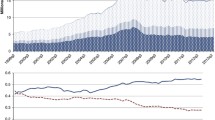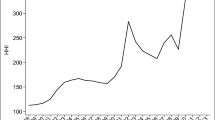Abstract
We estimate the effect of the distribution of banks by asset size on a country’s propensity to engage in cross-border banking. Countries where the distribution of banks by asset size is more skewed to the right (with few large and many small banks) lend more abroad and are recipients of more funds from foreign banks. This is consistent with the fact that large banks, with easier access to the international financial markets, act as a hub for smaller banks and at the same time stand out as safer too-big-to fail counterparts for foreign partners.

Similar content being viewed by others
Notes
These include the volume of bilateral phone traffic, the bilateral trade in newspapers, and bilateral migration flows.
Lending countries are Australia, Austria, Belgium, Brazil, Canada, Chile, Chinese Taipei, Denmark, Finland, France, Germany, Greece, Hong Kong SAR, India, Ireland, Italy, Japan, Korea, Luxembourg, Mexico, Netherlands, Panama, Portugal, Singapore, Spain, Sweden, Switzerland, Turkey, United Kingdom, United States.
See Avdjiev et al. (2015) for an accurate and updated description of the BIS CBS database.
Although the BIS Consolidated banking statistics database (CBS) suffers from number of structural breaks, in our sample their size is never larger than 2% of the total value of total claims, with the only exception of the first quarter of 2009, when it reaches 4%.
We thank an anonymous referee for suggesting this check.
For example, in 2010 the ratio the sum of total assets of individual banks reported in Bankscope to that in the IMF database ranges from a bit less than 60% in Bosnia Herzegovina, to 77% in Russia, 90% in the United Kingdom, 100% in Turkey and in the Czech Republic, to values larger than 100% in other countries.
Our results are confirmed when the analysis is conducted on the full sample of countries and on a sample of countries for which at least 25 banks are present.
In unreported regressions, available upon request, we have verified that we obtain similar results measuring competition with the Lerner index produced by the World Bank.
Unfortunately, the ratio of total assets of foreign banks to total bank assets is available only for a smaller subset of countries in our sample; however, for these countries the correlation between these two measures is positive and highly statistically significant.
Reassuringly, the coefficients obtained from estimates on the whole sample from the first and second stage regressions are very similar.
Although Barba Navaretti et al. (2010) provide evidence that at the aggregate local claims in foreign currency of foreign affiliates are of very limited relevance, this may not be the case for some emerging and developing countries like Ecuador, El Salvador and Panama, that are fully dollarized, or others where the levels of foreign-currency denominated domestic loans is very high, such as Bolivia, Peru, Uruguay, Bulgaria and Hungary. To check that our results are not affected by the role of local claims in foreign currencies, we have estimated our model excluding all the countries listed above. Reassuringly, the results are broadly unchanged. We thank an anonymous reviewer for pointing out this potentially very relevant issue.
Affinito and Pozzolo (2017) provide some evidence confirming that banks more active in the international markets are also more interconnected within the domestic interbank market.
Results are broadly identical extending the subsamples to include the crisis period, considering the years 2000-2007 and 2008-2013.
We thank an anonymous reviewer also for this interesting suggestion.
References
Acharya VV (2003) Is the international convergence of capital adequacy regulation desirable? J Financ 58(6):2745–2782
Affinito M, Pozzolo AF (2017) The interbank network across the global financial crisis: evidence from Italy. J Bank Financ 80:90–107
Amiti M, McGuire P, Weinstein DE (2017) Supply- and demand-side factors in global banking. NBER Working Paper No. 23536
Anderson JE, van Wincoop E (2003) Gravity with gravitas: a solution to the border puzzle. Am Econ Rev 93:170–192
Avdjiev S, McGuire P, Wooldridge P (2015) Enhanced data to analyse international banking. BIS Quarterly Review, September pp 53–68
Barba Navaretti G, Bugamelli M, Forlani E, Ottaviano GI (2019) It takes (more than) a moment: revisiting the link between firm productivity and aggregate exports. Mimeo
Barba Navaretti G, Calzolari G, Pozzolo AF, Levi M (2010) Multinational banking in Europe - financial stability and regulatory implications: lessons from the financial crisis. Econ Policy 25:703–753
Bas M, Mayer T, Thoenig M (2015) From micro to macro: demand, supply, and heterogeneity in the trade elasticity. Banque de France Working Paper No. 560, available at SSRN
Berger AN, Miller NH, Petersen MA, Rajan RG, Stein JC (2005) Does function follow organizational form? Evidence from the lending practices of large and small banks. J Financ Econ 76:237–269
Bernard AB, Jensen JB, Redding S, Schott PK (2007) Firms in international trade. J Econ Perspect 21:105–130
Boone J (2008) A new way to measure competition. Econ J 118:1245–1261
Bouvatier V, Delatte A-L (2015) Waves of international banking integration: a tale of regional differences. Eur Econ Rev 80(C):354–373
Buch CM, Koch CT, Koetter M (2014a) Should I stay or should I go? bank productivity and internationalization decisions. J Bank Financ 42:266–282
Buch CM, Neugebauer K, Schröder C (2014b) Changing forces of gravity: how the crisis affected international banking. ZEW-Centre for European Economic Research Discussion Paper (14-006)
Caballero RJ (2010) The “Other” imbalance and the Financial Crisis NBER Working Papers 15636, National Bureau of Economic Research, Inc
Claessens S, van Horen N (2014) Foreign banks: trends and impact. J Money, Credit, Bank 46:295–326
Coeurdacier N, Martin P (2009) The geography of asset trade and the euro: insiders and outsiders. Journal of the Japanese and International Economies 23:90–113
Daude C, Fratzscher M (2008) The pecking order of cross-border investment. J Int Econ 74(1):94–119
Duprey T, Le M (2016) Bankscope dataset: getting started
Ennis HM (2001) On the size distribution of banks. FRB Richmond Economic Quarterly 87(4):1–25
Eaton J, Kortum S (2002) Technology, geography, and trade. Econometrica 70:1741–1779
Fernandez A, Klein MW, Rebucci A, Schindler M, Uribe M (2015) Capital control measures: a new dataset NBER Working Papers 20970, National Bureau of Economic Research, Inc
Focarelli D, Pozzolo AF (2001) The patterns of cross-border bank mergers and shareholdings in OECD countries. J Bank Financ 25:2305–2337
Haldane AG (2009) Comment on “capital flows and asset prices”. In: NBER international seminar on macroeconomics 2007. NBER Chapters. National Bureau of Economic Research, Inc, pp 217–223
Head K, Mayer T (2014) Gravity equations: workhorse, toolkit, and cookbook. In: Helpman E, Rogoff K, Gopinath G (eds) Handbook of international economics, vol 4. Elsvier
Head K, Ries J (2008) FDI as an outcome of the market for corporate control: theory and evidence. J Int Econ 74(1):2–20
Helpman E, Melitz J, Yeaple SR (2004) Export versus FDI with heterogeneous firms. Am Econ Rev 94:300–316
Houston JF, Lin C, Ma Y (2012) Regulatory arbitrage and international bank flows. J Financ 67(5):1845–1895
Kleimeier S, Sander H, Heuchemer S (2014) The resurgence of cultural borders in international finance during the financial crisis: evidence from eurozone cross-border depositing Research Memorandum 013, Maastricht University, Graduate School of Business and Economics (GSBE)
Kose MA, Prasad E, Rogoff K, Wei SJ (2009) Financial globalization: a reappraisal. IMF Staff Pap 56:8–62
Lane PR, Milesi-Ferretti GM (2007) The external wealth of nations mark II: revised and extended estimates of foreign assets and liabilities, 1970–2004. J Int Econ 73:223–250
Martin P, Rey H (2004) Financial super-markets: size matters for asset trade. J Int Econ 64:335–361
Mayer T, Zignago S (2011) Notes on CEPII’s distances measures: the GeoDist database. CEPII Working Paper 2011–25
Melitz M (2003) The impact of trade on intra-industry reallocations and aggregate industry productivity. Econometrica 71(6):1695–1725
Melitz M, Redding S (2015) New trade models, new welfare implications. Am Econ Rev 105:1105–1146
Morrison AD, White L (2009) Level playing fields in international financial regulation. J Financ 64(3):1099–1142
Niepmann F (2015) Banking across borders. J Int Econ 96(2):244–265
Niepmann F, Schmidt-Eisenlohr T (2013) Banks in international trade finance: evidence from the U.S. Staff Reports 633, Federal Reserve Bank of New York
Okawa Y, van Wincoop E (2012) Gravity in international finance. J Int Econ 87(2):205–215
Ottaviano G, Mayer T (2011) The happy few: the internationalisation of European firms. No. 12 in Blueprints. Bruegel
Papaioannou E (2009) What drives international financial flows? Politics, institutions and other determinants. J Dev Econ 88(2):269–281
Pietrovito F, Pozzolo AF, Salvatici L (2013) Internationalization choices: an ordered probit analysis at industry level. Empir Econ, 50(2):561–594
Portes R, Rey H (2005) The determinants of cross-border equity flows. J Int Econ 65(2):269–296
Schmidt-Eisenlohr T (2013) Towards a theory of trade finance. J Int Econ 91 (1):96–112
Tinbergen J (1962) Shaping the world economy: suggestions for an international economic policy, Twentieth Century Fund, New-York
Acknowledgments
We would like to thank the lead guest editor, Warren Bailey, and an anonymous reviewer for excellent comments, and also Rebel Cole (discussant), Travis Selmier II (discussant), Olivier De Jonghe, and seminar participants at the Portsmouth-Fordham Conference on Banking & Finance, 24–25 September 2016, at the Rome International Conference on Money Banking and Finance, 1–2 December 2016, and at the 2016 World Finance and Banking Symposium in Dubai, 15–16 December 2016. Giorgio Barba Navaretti acknowledges funding by the Centro Studi Luca d’Agliano within the project “Banks heterogeneity and capital flows”. The usual disclaimers apply.
Author information
Authors and Affiliations
Corresponding author
Additional information
Publisher’s Note
Springer Nature remains neutral with regard to jurisdictional claims in published maps and institutional affiliations.
Rights and permissions
About this article
Cite this article
Navaretti, G.B., Calzolari, G., Pozzolo, A.F. et al. Few Large with Many Small: Banks Size Distribution and Cross-Border Financial Linkages. J Financ Serv Res 56, 229–258 (2019). https://doi.org/10.1007/s10693-019-00325-5
Received:
Revised:
Accepted:
Published:
Issue Date:
DOI: https://doi.org/10.1007/s10693-019-00325-5




